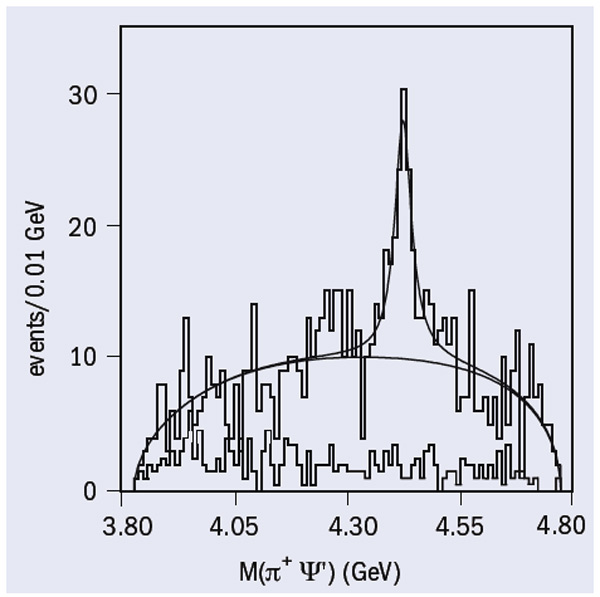The Belle collaboration at KEK has recently announced the discovery of an exotic new particle with non-zero electric charge. This particle, which the researchers have named the Z(4430), does not fit into the usual scheme of mesons.

The Z(4430) particle has appeared in the decay products of B mesons (containing a bottom quark), which are produced in large numbers at KEKB, the B-factory at the KEK laboratory in Japan. While investigating various decays of B mesons in a data sample containing nearly 660 million pairs of B and anti-B mesons, the Belle team observed 120 B mesons that decay into a Z(4430) and a K meson. The Z(4430) then instantly decays into a Ψ’ and a π meson. The team found that the new particle has negative charge and a mass about 4.7 times that of the proton.
Both Belle and the BaBar experiment at SLAC have found a number of peculiar new particles during the past few years, such as the X(3872), Y(4260), X(3940) and Y(3940). These all have masses in the region of 4–4.5 times the proton’s mass, and decay into J/Ψ or Ψ’ particles and π mesons. A simple explanation for these particles would be that they are examples of charmonium, the family of bound states of a charm quark (c) and antiquark (c̅) that includes the J/Ψ and Ψ’. However, their masses and decay properties do not match theoretical expectations for charmonium, so theorists have proposed other explanations.
One possibility is that some of the new particles are multiquark states containing a c and (c) together with another lighter quark and antiquark, for example, an up quark (u) and antiquark (u) or down quark (d) and antiquark (d). However, because the particles previously discovered are electrically neutral, it has not been possible experimentally to rule out entirely that they are unusual charmonium states.
The newly discovered Z(4430), on the other hand, has non-zero electric charge, a characteristic that clearly distinguishes it from charmonium. This raises the possibility that it could be indeed be a multiquark state, containing a c and c̅ together with a quark and different antiquark, for example cuc d.





